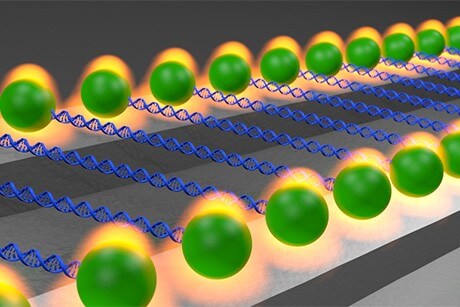Optical trapping, a technique for studying single molecules, is traditionally delicate, requiring special equipment and a soundproof room, with data collected one molecule at a time.
Cornell physicists have shrunk the technology of an optical trap, which uses light to suspend and manipulate molecules like DNA and proteins, onto a single chip. And instead of just one molecule at a time, the new device can potentially trap hundreds of molecules at once, reducing month-long experiments to days.
“We love single-molecule experiments because the data are beautiful and clear, and we learn so much by manipulating and perturbing molecules and watching how things change,” said Michelle Wang, professor of physics, who led the study published online in Nature Nanotechnology April 28. But the experimental technique itself could use some improvement, which motivated Wang, who studies DNA and its associated motor proteins, to contemplate solutions.
Wang and colleagues developed a new type of optical trap, drawing on nanophotonics – in this case, using light as nanoscale controllers – as well as on-chip electronics and microfluidics to make a low-power, stable device that can be fitted to conventional microscopes.
Their key innovation is the generation of controllable optical standing waves in nanophotonic waveguides, formed by two counter-propagating light waves, which function as optical trap arrays. This design recycles the same light to produce multiple traps, each of which can hold one molecule, for example, a single molecule of DNA.
“What we have here is a stable and controllable three-dimensional trap array,” Wang said. “That’s never been done before.” They call their device a nanophotonic standing wave array trap, or nSWAT.
To test the device’s stability – a key breakthrough – lab members physically tapped on the microscope where they’d mounted their chip. Due to the compact nature of the device, which fits on a penny, they detected little, if any disturbance.
In their paper, they also described transporting molecules over a relatively long distance using the waveguides. This ability lets the new optical trap integrate with existing fluorescence labeling techniques for tagging molecules of interest.
Fabrication of the nSWAT was done exclusively at the Cornell NanoScale Science and Technology Facility (CNF).
Experiments described in the paper, “Nanophotonic trapping for precise manipulation of biomolecular arrays,” were completed primarily by co-first authors Mohammad Soltani and Jun Lin, both postdoctoral associates in the Wang lab, with substantial help from several students and postdocs in the lab. Early stages of the project involved helpful discussions with, and loaned equipment from, co-author Michal Lipson, professor of electrical and computer engineering, a nanophotonics expert.
The American Cancer Society, National Institutes of Health, National Science Foundation, and the Howard Hughes Medical Institute, where Wang is an investigator, provided funding.



Nanotechnology is without doubt growing at an enormous pace. It seems that most of our future is in fact going to exist out of nanotechnology. The amazing part about this new founding is that this way of using light as nanoscale controllers can be fitted into conventional microscopes which makes this new technology both affordable and easy to gain access to, seeing that new microscopes are not needed. Although the technology is still experimental, it is most certainly going to be used in the future and is another exciting addition to science.
The uses of Nano chip technology is becoming increasingly popular. This sort of technology will change the fields of pharmaceuticals, cosmetic testing and pathology research. The current pharmaceutical testing is proving to be costly and inaccurate. The methods of animal testing has proven to be controversial and most cases the way the animal reacts is not the same the same way a human would react. Another method is harvesting cells in petri dishes. Often this method does not work as cells aren’t able to survive in these environments. Therefore the uses of this chip would be a perfect way to solve problems such as these.
These new optical traps which have been created could have endless possibilities for the human race. Now that we can study multiple molecules at a faster rate, we can get more research done in the same amount of time. With the rate of research and testing being increased, it means that we can find the solutions to specific molecule related problems much faster to.
I would like to know though, why people are studying these individual molecules very intensely. What are scientists and other professions alike hoping to gain from studying these individual molecules so intensely? Is this one way of developing cures to certain sicknesses, or is all this research just to help us better understand the molecules that are around us every day?
This entire field of science really does sound interesting, and it seems as though they will possibly be having some major breakthroughs soon. I believe that this increased ability to study more molecules at the same time can only benefit society in the future. So let’s hope that these scientists and other professions involved start doing the best that they can with this new technology, in order to benefit the world somehow in the future.
This is an amazing breakthrough in optical trapping. It is incredible for one thing that we can now complete the process of optical trapping in a few days. For another, we can do it for multiple molecules at once. This breakthrough will have massive impact on the rate of discovery due to the increase in effectiveness of optical trapping experiments. 14132126